Bake with Ease: The Ultimate Guide to 5 Delicious Almond Flour Cookie Recipes
Your definitive guide to baking with almond flour. Master 5 delicious, easy cookie recipes and learn all the tips for perfect gluten-free treats every time.
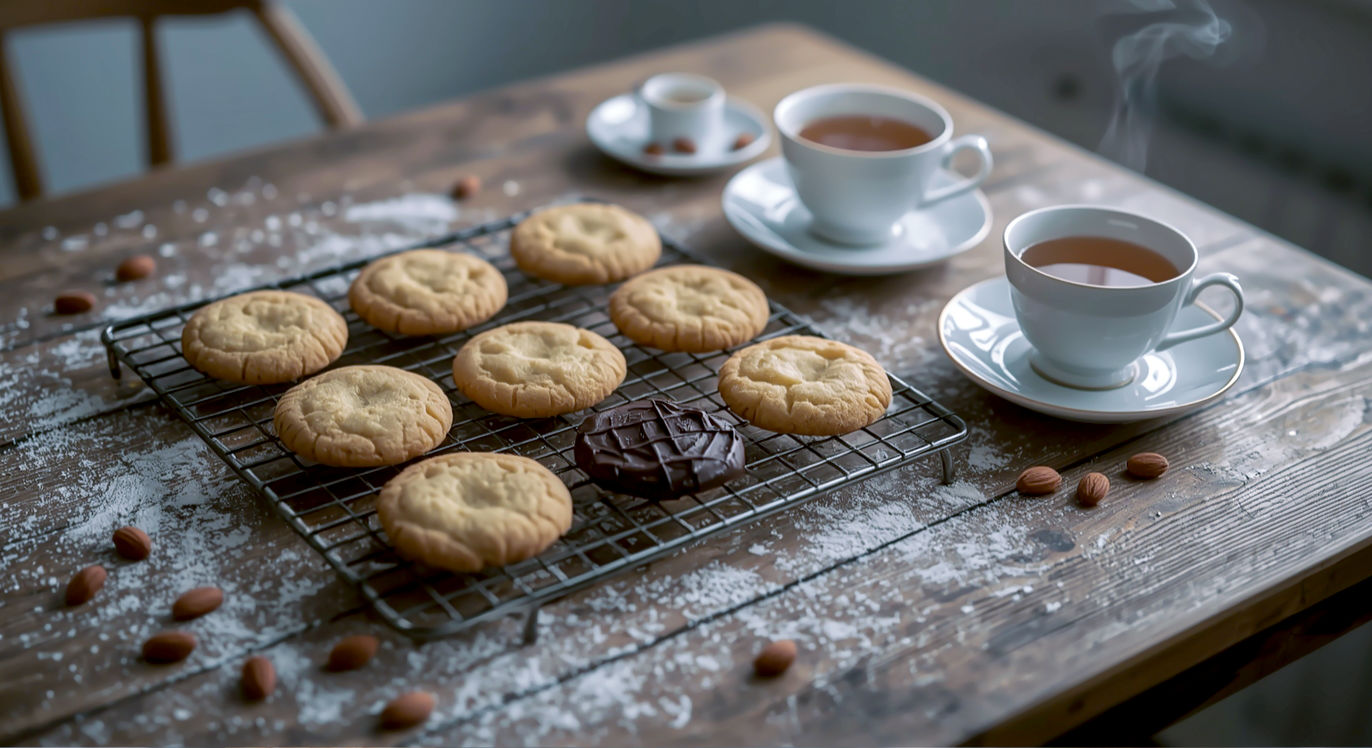
This post may contain affiliate links. If you make a purchase through these links, we may earn a commission at no additional cost to you.
There’s a simple, almost magical, comfort in the smell of freshly baked biscuits wafting from the kitchen. It’s a feeling that’s deeply woven into the fabric of British life, right up there with a good cup of tea and complaining about the weather. For years, that comforting ritual has been built on a foundation of plain wheat flour. But what if I told you there’s another way? A way to create biscuits that are not only incredibly delicious, with a wonderfully rich flavour and tender texture, but are also naturally gluten-free and lower in carbs?
Welcome to the wonderful world of almond flour.
If you’ve spotted bags of it popping up in the “free-from” aisle at Tesco or seen it championed by health-conscious bakers online, you might be curious. You might even be a little sceptical. Can ground almonds really replace the flour we’ve used for generations? The answer is a resounding yes.
This isn’t just about making a “good enough” substitute. It’s about discovering a whole new way to bake that yields uniquely satisfying results. Almond flour cookies aren’t just gluten-free cookies; they are a treat in their own right, with a moist, chewy interior and a flavour that plain flour simply can’t match.
This guide is your ultimate resource for mastering almond flour baking. We’ll explore what it is, why it’s so brilliant, and the simple tips you need to get it right every time. And, of course, we’ll dive into five foolproof recipes, from the ultimate chewy chocolate chip cookie to a zesty lemon shortbread that’s just begging for a cup of Earl Grey. So, pop the kettle on, and let’s get baking.
What’s All the Fuss About Almond Flour?
Before we start creaming butter and sugar, let’s get to know our star ingredient. Understanding what almond flour is and how it works is the first step to becoming a confident almond flour baker.
What exactly is it?
At its simplest, almond flour is just very finely ground almonds. That’s it. There’s no complex milling process, no bleaching, no additives. It’s a whole-food ingredient that’s as straightforward as it sounds. To make it, almonds are typically blanched—meaning their skins are removed by briefly boiling them—and then ground into a powder with a consistency similar to traditional wheat flour.
This process gives it a pale, creamy colour and a light texture, making it perfect for delicate bakes where you want a fine crumb.
Almond Flour vs. Almond Meal: A Baker’s Guide
You might see “almond meal” or “ground almonds” sitting next to almond flour on the shelf. While they’re very similar, there’s a key difference a baker should know.
- Almond Flour: Made from blanched almonds (skins removed). The result is a finer, lighter, and more uniform powder. This is what you want for most cakes, macarons, and cookies where a delicate texture is key.
- Almond Meal / Ground Almonds: Made from almonds with their skins left on. This results in a coarser, darker, and slightly more “rustic” flour with brown flecks. It’s fantastic for heartier bakes like rustic tarts, dense cakes, and as a breading for fish or chicken.
For the recipes in this guide, we’ll be using blanched almond flour to get that perfect cookie texture. If you only have ground almonds, they will work in a pinch, but your cookies will be a bit denser and darker.
Why It’s Brilliant for Baking
So, why are bakers across the UK falling in love with this stuff? It comes down to a few key benefits.
- Naturally Gluten-Free: This is the big one. Almond flour contains zero gluten, making it a fantastic and wholesome choice for anyone with coeliac disease, a gluten sensitivity, or who is simply trying to reduce the gluten in their diet.
- Incredible Flavour and Moisture: Unlike plain flour, which is mostly a neutral carrier for other flavours, almond flour brings its own delicious, nutty, and slightly sweet taste to the party. It’s also high in healthy fats, which translates to bakes that are wonderfully moist and tender. No more dry, crumbly gluten-free biscuits!
- Lower in Carbs, Higher in Nutrients: For those watching their carb intake, almond flour is a game-changer. It’s significantly lower in carbohydrates and higher in protein, fibre, healthy fats, vitamin E, and magnesium than traditional flour. It makes for a more satisfying and blood-sugar-friendly treat.
- Creates a Wonderful Texture: The lack of gluten and high fat content gives almond flour bakes a unique texture. Cookies are often chewier and softer, while cakes have a tender, melt-in-the-mouth quality.
Your Almond Flour Baking Toolkit: Tips for Perfect Cookies Every Time
Baking with almond flour is incredibly easy, but it does behave a little differently from wheat flour. Keep these simple tips in your back pocket, and you’ll be turning out perfect batches from day one.
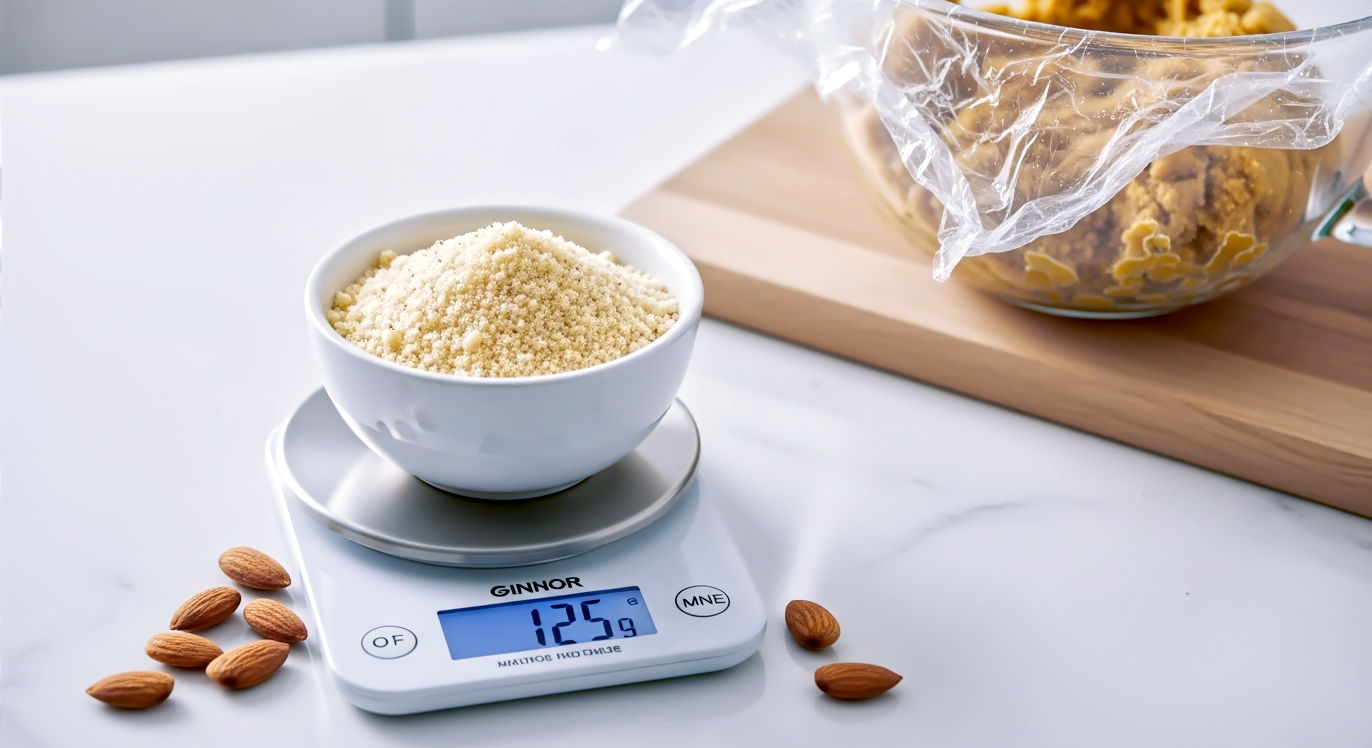
Measuring Matters: The Secret to Consistency
Baking is a science, and accuracy is key. This is especially true with almond flour.
The best way to measure almond flour is with a digital kitchen scale. It’s the only way to guarantee you’re using the exact amount the recipe calls for. Grams don’t lie!
If you must use measuring cups, use the “scoop and level” method. Use a spoon to fluff up the flour in its bag, then spoon it into your measuring cup until it’s overflowing. Finally, use the straight edge of a knife to level it off. Don’t be tempted to pack it down, or you’ll end up with too much flour and a dry, dense cookie.
Taming the Spread: How to Stop Your Cookies from Going Flat
One common issue bakers face with almond flour is cookies that spread too much in the oven, turning into thin, crispy wafers. This happens because the high fat content in the almonds melts, and there’s no gluten to provide structure.
But don’t worry, the fix is simple: chill your dough!
After you’ve mixed your cookie dough, cover it and pop it in the fridge for at least 30-60 minutes. This solidifies the fats, meaning they melt more slowly in the oven. This gives the cookie’s structure time to set before the spread takes over, resulting in a thicker, chewier biscuit. For some recipes, you can even freeze the balls of dough for 15 minutes for extra security.
Common Pitfalls and How to Dodge Them
- The Burn: Almond flour browns much faster than wheat flour due to its higher fat and protein content. Keep a close eye on your cookies while they bake. They might look done on top a few minutes before you expect them to be. It’s also a good idea to bake them in the centre of the oven to ensure even heat.
- The Crumble: If your cookies are falling apart, it could be a couple of things. You might have over-baked them, or the dough might have needed a little more binder (like an egg or a touch more liquid). Also, be gentle! Almond flour cookies are very delicate when they first come out of the oven. Let them cool on the baking tray for 5-10 minutes before even thinking about moving them to a wire rack. This gives them time to firm up.
- The Wrong Texture: If your cookies feel oily or heavy, you may have used almond meal instead of fine almond flour. For the best results, stick to a good-quality, finely ground blanched almond flour.
Storing Your Bakes (and the Flour Itself)
For the Cookies: Once completely cool, store your almond flour cookies in an airtight container at room temperature. They’ll stay fresh for up to 5 days. Because of their high moisture content, they stay wonderfully soft.
For the Flour: Almond flour’s high fat content means it can go rancid more quickly than wheat flour. Store it in an airtight container in a cool, dark place (like a pantry). For long-term storage, keep it in the fridge or even the freezer.
The Recipes: Five Foolproof Almond Flour Cookies
Now for the fun part! Here are five tried-and-tested recipes to get you started. They range from timeless classics to modern favourites, all designed to be simple, straightforward, and utterly delicious.
Recipe 1: The Ultimate Chewy Chocolate Chip Cookie
This is the recipe that will convince any almond flour sceptic. It’s soft, chewy, packed with melted chocolate, and has a rich, buttery flavour that’s simply irresistible.

Introduction: A great chocolate chip cookie is a thing of beauty. This almond flour version ticks all the boxes: a slightly crisp edge, a gooey centre, and puddles of dark chocolate in every bite. The almond flour adds a depth of flavour that makes them feel just a little bit more grown-up.
Ingredients:
- 280g fine blanched almond flour
- 1/2 tsp bicarbonate of soda
- 1/2 tsp sea salt
- 115g unsalted butter, softened
- 150g soft light brown sugar (or coconut sugar)
- 1 large free-range egg
- 1 tsp vanilla extract
- 180g dark chocolate chips or a chopped dark chocolate bar
Instructions:
- Combine Dry Ingredients: In a medium bowl, whisk together the almond flour, bicarbonate of soda, and sea salt. This gets rid of any lumps and ensures everything is evenly distributed.
- Cream Butter and Sugar: In a separate, larger bowl, use an electric mixer or a wooden spoon to cream the softened butter and brown sugar together until light and fluffy. This should take about 2-3 minutes.
- Add Wet Ingredients: Beat in the egg and vanilla extract until just combined. Don’t over-mix here.
- Mix Together: Gradually add the dry ingredients to the wet ingredients, mixing on a low speed (or by hand) until a dough forms. Again, be careful not to over-mix.
- Fold in Chocolate: Gently fold in the chocolate chips with a spatula.
- Chill the Dough: Cover the bowl and refrigerate the dough for at least 1 hour. This step is crucial for thick, chewy cookies!
- Preheat and Prep: When you’re ready to bake, preheat your oven to 180°C (160°C Fan) and line two baking trays with baking parchment.
- Scoop and Bake: Roll the chilled dough into tablespoon-sized balls (about 40g each) and place them on the prepared trays, leaving plenty of space between them for spreading.
- Bake: Bake for 10-13 minutes, or until the edges are golden brown and the centres look slightly soft. They will continue to cook on the hot tray.
- Cool Down: Let the cookies cool on the baking trays for at least 10 minutes before carefully transferring them to a wire rack to cool completely.
Baker’s Notes:
- For extra flavour, sprinkle a little flaky sea salt on top of the cookies before baking.
- Don’t be afraid to experiment with add-ins. Chopped walnuts or pecans are a wonderful addition.
- If you prefer a crispier cookie, you can flatten the dough balls slightly with your palm before baking.
Recipe 2: Zesty Lemon Shortbread Biscuits
Classic, buttery shortbread gets a sophisticated, gluten-free makeover. The rich almond flour is the perfect partner for the bright, zesty lemon. These are delicate, melt-in-the-mouth biscuits perfect for an afternoon cuppa.
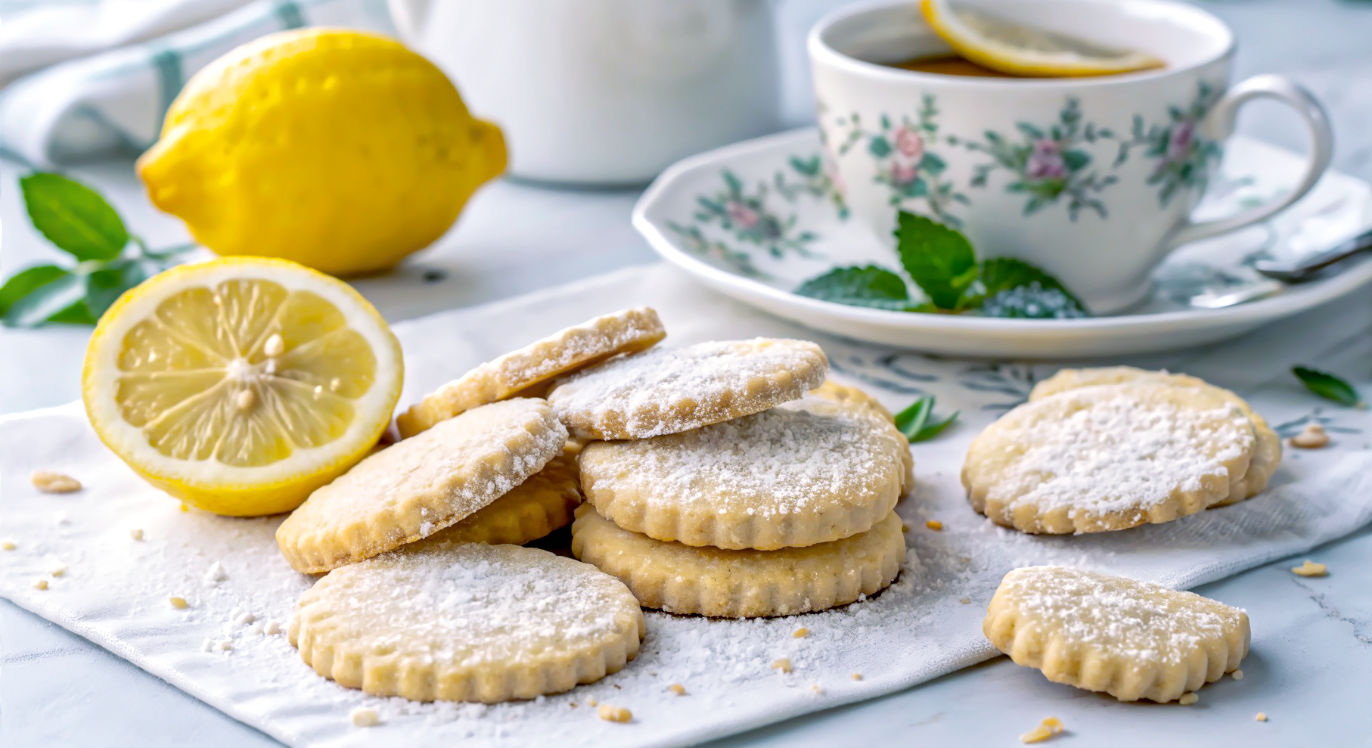
Introduction: There’s something wonderfully elegant about shortbread. These biscuits are incredibly simple but taste luxurious. The almond flour gives them a tender crumb that’s a step above traditional shortbread, while the lemon zest cuts through the richness beautifully.
Ingredients:
- 240g fine blanched almond flour
- 60g icing sugar, plus extra for dusting
- 1/4 tsp sea salt
- Zest of 1 large lemon
- 115g unsalted butter, cold and cubed
- 1 tsp vanilla extract
Instructions:
- Pulse Dry Ingredients: In a food processor, add the almond flour, icing sugar, sea salt, and lemon zest. Pulse a few times to combine.
- Add Butter: Add the cold, cubed butter and vanilla extract. Pulse until the mixture resembles coarse breadcrumbs. Be careful not to over-process; you don’t want it to turn into a paste.
- Form the Dough: Tip the mixture out onto a clean surface and bring it together with your hands, kneading gently until it forms a smooth dough.
- Shape and Chill: Form the dough into a log about 5cm (2 inches) in diameter. Wrap it tightly in cling film and chill in the fridge for at least 1 hour until firm.
- Preheat and Slice: Preheat your oven to 170°C (150°C Fan) and line a baking tray with baking parchment. Unwrap the chilled dough log and use a sharp knife to slice it into rounds about 1cm (1/3 inch) thick.
- Bake: Place the slices on the prepared tray. They won’t spread much, but leave a little space between them. Bake for 12-15 minutes, or until the edges are just beginning to turn a very pale golden colour. They should not be brown.
- Cool: Let the shortbread biscuits cool on the baking tray for 10-15 minutes before moving them to a wire rack. They are extremely delicate when hot.
- Dust (Optional): Once cool, you can dust them with a little extra icing sugar.
Baker’s Notes:
- For a lemon drizzle version, mix a few tablespoons of icing sugar with a squeeze of fresh lemon juice and drizzle it over the cooled biscuits.
- You can swap the lemon zest for orange zest or even add 1/2 teaspoon of rosewater for a more fragrant twist.
- The unbaked dough log can be frozen for up to 3 months. Simply slice and bake from frozen, adding a couple of extra minutes to the baking time.
Recipe 3: Fiery Ginger & Almond Biscuits
If you love a biscuit with a bit of a kick, this one’s for you. These chewy, spicy ginger biscuits have a lovely warmth from the ginger and a deep, caramel flavour from the molasses.
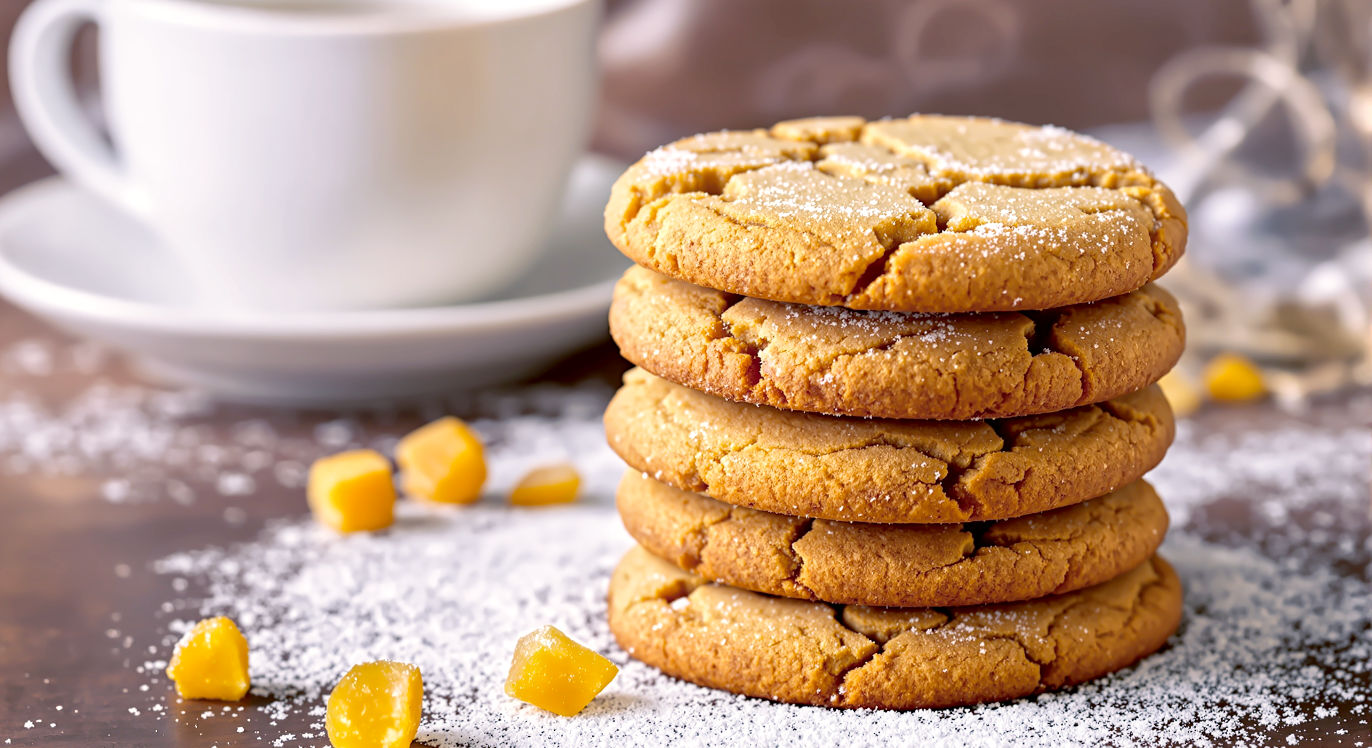
Introduction: This is the kind of biscuit you want on a cold, rainy afternoon. It’s robust, flavourful, and deeply comforting. The almond flour base keeps it soft and chewy, while the combination of ground ginger and crystallised ginger provides a double dose of warmth.
Ingredients:
- 250g fine blanched almond flour
- 1 tsp ground ginger
- 1/2 tsp ground cinnamon
- 1/2 tsp bicarbonate of soda
- 1/4 tsp sea salt
- 85g unsalted butter, melted
- 80ml black treacle or molasses
- 1 large free-range egg yolk
- 50g crystallised ginger, finely chopped
- Caster sugar, for rolling (optional)
Instructions:
- Mix Dry Ingredients: In a large bowl, whisk together the almond flour, ground ginger, cinnamon, bicarbonate of soda, and salt.
- Mix Wet Ingredients: In a separate smaller bowl, whisk the melted butter, black treacle, and egg yolk until well combined.
- Combine: Pour the wet ingredients into the dry ingredients and mix until a sticky dough forms. Fold in the finely chopped crystallised ginger.
- Chill: Cover the bowl and chill the dough for at least 30 minutes to make it easier to handle.
- Preheat and Prep: Preheat your oven to 180°C (160°C Fan) and line a baking tray with baking parchment.
- Roll and Bake: If using, place some caster sugar on a small plate. Roll the dough into small balls (about 30g each). Roll each ball in the caster sugar to coat, then place on the baking tray, leaving room for spreading.
- Bake: Bake for 9-11 minutes. The cookies will puff up and then settle, and the edges should be set. They will feel very soft in the centre.
- Cool: Let them cool on the tray for at least 10 minutes to firm up before transferring to a wire rack. They will become chewier as they cool.
Baker’s Notes:
- Black treacle gives a deep, traditional flavour. If you can’t find it, dark molasses is a good substitute.
- For an even more intense flavour, you can add 1/4 teaspoon of freshly grated nutmeg.
- These biscuits are wonderful for making ice cream sandwiches.
Recipe 4: The Simplest Peanut Butter Cookie (Just 3 Ingredients!)
It doesn’t get easier than this. These cookies are unbelievably simple to make but deliver huge peanut butter flavour. They are naturally gluten-free and dairy-free, too.
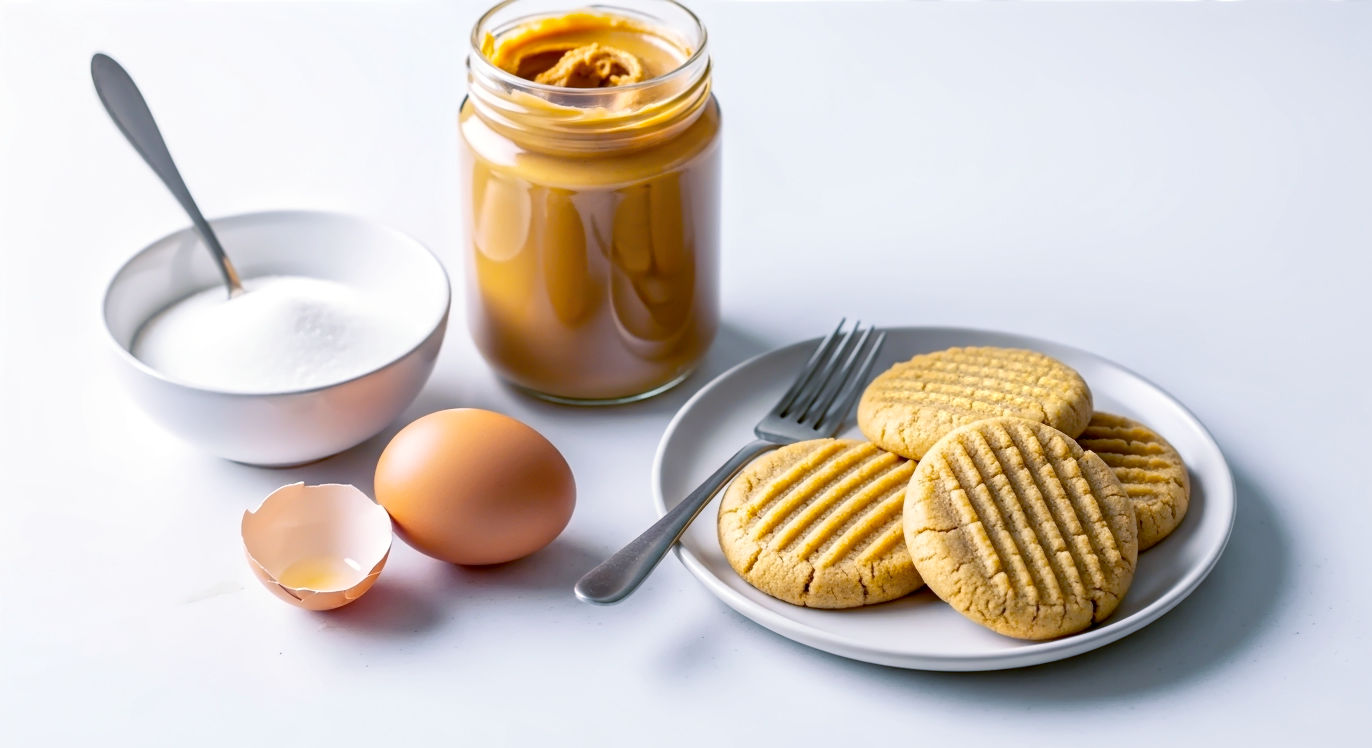
Introduction: Sometimes, you just want a cookie without any fuss. This is that cookie. With just three basic ingredients you probably already have in your pantry, you can whip up a batch of these soft, chewy, and intensely nutty cookies in under 20 minutes. They’re a brilliant recipe for baking with kids.
Ingredients:
- 225g smooth or crunchy peanut butter (use a brand with no added sugar)
- 100g caster sugar (or soft light brown sugar)
- 1 large free-range egg
Wait, where’s the almond flour? This is our bonus recipe! While it doesn’t use almond flour, it’s a testament to the magic of nut-based, flourless baking. It fits the ethos perfectly. For a true almond version, see the Baker’s Notes.
Instructions:
- Preheat and Prep: Preheat your oven to 180°C (160°C Fan) and line a baking tray with baking parchment.
- Mix Everything: In a medium bowl, combine the peanut butter, sugar, and egg. Mix with a spoon or spatula until a smooth, thick dough forms. That’s it!
- Scoop and Shape: Roll the dough into tablespoon-sized balls and place them on the prepared tray.
- Press: Use the back of a fork to gently press down on each ball, creating the classic criss-cross pattern. This also helps them bake more evenly.
- Bake: Bake for 10-12 minutes, until the edges are lightly golden. They will seem underdone in the middle.
- Cool: Allow the cookies to cool on the baking tray for 5-10 minutes before moving them to a wire rack. They will be very soft at first and will firm up as they cool.
Baker’s Notes:
- To make this an almond flour recipe: For a sturdier cookie, add 100g of almond flour to the mixture. This will create a cookie with a bit more body and a lovely almond-peanut flavour combination.
- Make sure you use regular peanut butter, not the oily “natural” kind where the oil separates, as it can make the cookies greasy.
- Feel free to stir in 100g of chocolate chips for an extra treat.
Recipe 5: Seriously Fudgy Double Chocolate Cookies
For the chocoholics, this one is pure indulgence. These cookies are rich, dark, and intensely chocolatey, with a texture that’s somewhere between a brownie and a cookie.

Introduction: This is not a cookie for the faint of heart. It’s a deep, dark, and decadent treat. The almond flour enhances the fudgy texture, making them incredibly moist and ensuring the rich chocolate flavour is the star of the show.
Ingredients:
- 200g fine blanched almond flour
- 60g good-quality cocoa powder, sifted
- 1 tsp espresso powder (optional, but enhances chocolate flavour)
- 1/2 tsp bicarbonate of soda
- 1/4 tsp sea salt
- 115g unsalted butter, softened
- 180g soft light brown sugar
- 1 large free-range egg
- 1 tsp vanilla extract
- 150g dark chocolate chunks or chips
Instructions:
- Combine Dry Ingredients: In a medium bowl, whisk together the almond flour, sifted cocoa powder, espresso powder (if using), bicarbonate of soda, and salt.
- Cream Butter and Sugar: In a larger bowl, beat the softened butter and brown sugar with an electric mixer until creamy and pale, about 2 minutes.
- Add Egg and Vanilla: Beat in the egg and vanilla extract until just combined.
- Mix Dough: On a low speed, gradually add the dry ingredients to the wet ingredients, mixing until just incorporated. Don’t over-mix.
- Fold in Chocolate: Use a spatula to gently fold in the dark chocolate chunks.
- Chill the Dough: The dough will be soft. Cover and chill it in the fridge for at least 1 hour until firm enough to scoop.
- Preheat and Prep: Preheat your oven to 180°C (160°C Fan) and line two baking trays with baking parchment.
- Scoop and Bake: Scoop rounded tablespoons of the chilled dough onto the trays, leaving plenty of space between them.
- Bake: Bake for 11-13 minutes. The edges should be set, but the centres will still be very soft.
- Cool: This is critical! Let the cookies cool completely on the baking trays. They will be far too fragile to move when hot. They will firm up into fudgy perfection as they cool.
Baker’s Notes:
- Using Dutch-processed cocoa powder will give a darker colour and smoother chocolate flavour.
- For a triple chocolate hit, you could use a mix of dark, milk, and white chocolate chunks.
- A sprinkle of flaky sea salt on top before baking perfectly balances the sweetness.
Beyond the Biscuit Tin: Almond Flour FAQs
You’ve got the recipes, you’ve got the tips, but you might still have a few questions. Let’s clear them up.
Can I swap almond flour 1:1 for plain flour in my own recipes?
In a word, no. Almond flour and wheat flour are completely different beasts. Almond flour has more moisture, more fat, and no gluten. A direct swap will likely result in a dense, oily, and flat bake. It’s always best to follow recipes specifically developed for almond flour.
Is almond flour healthy?
Yes, in moderation, it’s a very nutritious choice. It’s packed with healthy monounsaturated fats, protein, vitamin E, and magnesium. It’s also much lower in carbohydrates than regular flour, making it a great option for those managing their blood sugar. Of course, we are still talking about biscuits, so they’re a treat!
Where can I buy good almond flour in the UK?
It’s easier to find than ever. Most large supermarkets (like Sainsbury’s, Tesco, and Waitrose) stock it in their baking or “free-from” aisles. You can also find it in health food shops like Holland & Barrett, or buy it in bulk online for better value. Look for brands that specify “fine” or “superfine” blanched almond flour.
Can I make my own almond flour?
You can! It’s a great way to save a bit of money. You’ll need blanched whole almonds and a powerful blender or food processor. Simply pulse the almonds until they reach a fine, flour-like consistency. The key is to use short pulses and be very careful not to over-blend, or you’ll quickly end up with almond butter!
Your Baking Adventure Awaits
Baking with almond flour isn’t about restriction or complicated science; it’s about discovery. It’s about finding new textures, richer flavours, and creating delicious treats that more people can enjoy.
Whether you’re a seasoned baker looking for a new challenge or someone just starting on a gluten-free journey, these recipes are your gateway to a world of possibilities. They prove that you don’t need wheat to create something truly comforting and delicious.
So go on, pick a recipe, preheat your oven, and fill your home with that wonderful, magical smell. A perfect, chewy, and wholesome almond flour cookie—and a well-deserved cuppa—is just a few simple steps away. Happy baking!
Further Reading
For more inspiration on gluten-free and alternative baking, explore these excellent resources:
- BBC Good Food: A trusted source for thousands of recipes, including a wide variety of gluten-free bakes.
- Delicious. Magazine: Offers beautifully curated recipes with a focus on quality ingredients, including many almond flour creations.
- Doves Farm: A specialist flour miller in the UK, their website is a fantastic resource for gluten-free baking advice and recipes.
- The Loopy Whisk: A brilliant blog by Katarina Cermelj, focusing on the science behind gluten-free baking for foolproof results.
